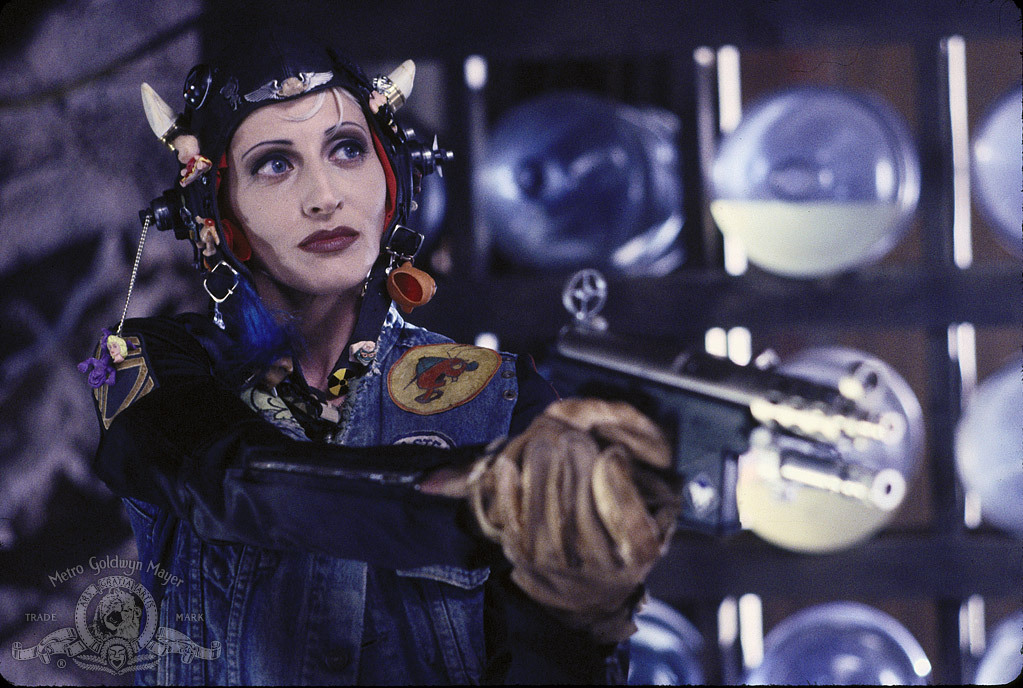
What is it? A famous bomb that slowly has inched its way back towards being a cult classic in some circles, Tank Girl is one of those comic book movies that came out before comic book movies were everywhere. It’s based on some freewheeling British comics by Alan Martin and Jamie Hewlett (who’d go on to co-create the band Gorillaz). Lori Petty stars as Tank Girl, a spunky punk-rock survivor in a vaguely post-apocalyptic Australian Outback world (in the far, far future of… gulp … 2033) where water is a commodity, ruled over by the corporation of the dictatorial Kesslee (Malcolm McDowell). Tank Girl becomes dragged into an uprising against corporate power, and joins forces with other outcasts and mutant kangaroos to fight evil in a very riot grrll way. While it’s remembered as a flop, it turns out Tank Girl is a gleefully oddball and slightly ahead-of-its-time feminist curio of a world before every comic book movie was envisioned as part of a cinematic universe.
Why I never saw it: In a sign of increasing senility, I always lumped Tank Girl into the list of movies I had seen at one point and forgot about (I did work for a video store a little back in the 1990s, after all). The back shelves of defunct video stores were littered with movies like The Phantom, Mystery Men, Barb Wire and Spawn that were clunky, low-budget attempts to turn comic books into gold. Most of them were awful, plagued by terrible scripts, dodgy special effects, or both, but at the same time they were often kind of interesting movies. Tank Girl failed at the box office, mystified most critics, and mostly went on to be known as that movie that featured rapper Ice-T under a lot of latex as a mutant kangaroo.

Does it measure up to its rep? Tank Girl is just original enough to become bizarrely enjoyable as Petty trash-talks her way through a dried-up world. The chaotic production was directed by Rachel Talalay, in an era where a woman directing a big blockbuster attempt was even rarer than it is now. Tank Girl has attitude and style mixed in with gritty practical effects and a little amateurism (those mutant kangaroos won’t win any make-up Oscars, mate). Iggy Pop pops up for about 30 seconds as a pedophile Tank Girl beats down, because why not? There’s also the ever-enjoyable scenery chewing of McDowell and a very young Naomi Watts as Tank Girl’s shy sidekick. The movie combines a smashing ‘90s soundtrack with cool colourful animated sequences styled after the comic strips. The movie isn’t anywhere near as raunchy or anarchic as the more free-wheeling comics, giving Tank Girl a more traditional heroic arc and a family, but it’s got enough of their basic spirit to feel rather fresh even now.
Worth seeing? Set aside your expectations for machine-tooled perfection and the kind of glossy anonymity too many recent superhero movies have settled for. Still, Tank Girl is a clear forerunner of recent superhero movie starlet Harley Quinn, a kick ass, anarchic female antihero who isn’t afraid to mix it up with any foe. I won’t claim Tank Girl is some lost masterpiece but at its heart, it’s kind of daft fun, with just enough of the punky frenzy of the British comics to make it still feel quietly a little revolutionary. They don’t make ’em like this any more.


























